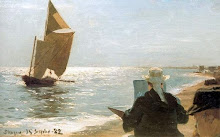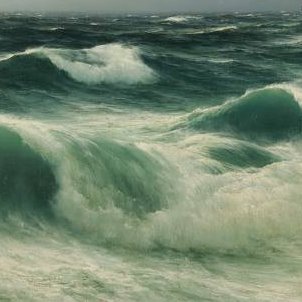Saturday, October 31, 2009
Sunday, October 25, 2009
Laura Knight - English
Wednesday, October 21, 2009
Seascape wins world's biggest art prize
Read more at in the real art world.blogspot
Tuesday, October 20, 2009
Charles William Wyllie 1853-1923
Sunday, October 18, 2009
Friday, October 16, 2009
Friday, October 9, 2009
Aelbert Cuyp
detail, National Gallery, London
When people hear the term "marine art" they often think of paintings on the walls of a stuffy men's club, but the best examples of painting in any genre are a treasure trove of learning for the oil painter.
Imitator of Thomas Couture
Wednesday, October 7, 2009
Saturday, October 3, 2009
Frederick Childe Hassam - American
Isles of Shoals,
Broad Cove,
1911
In this work by the American impressionist Childe Hassam, the interlocking areas of water and land are nearly the same in size and shape, creating a sort of yin yang symbol. This produces a visual ambiguity of figure and ground - the viewer's eye cannot fully decide if the land is the figure on the ground of the sea, or vice versa. This makes the composition more interesting.
Childe Hassam was one of the handful of artists who took the Impressionist style of landscape painting from Europe to America.
Thursday, October 1, 2009
Daniel Pinkham - American
Portuguese Point Nocturne, 8 x 8 inches
Two studies of the same subject - one at sunset and one by moonlight.
Making multiple studies of a single subject is a very instructive exercise. After the first study you are familiar enough with the general form of the scene to concentrate on other aspects of painting - such as colour and mood - in subsequent studies.
William Edward Norton - American 1843-1916

On the Coast of Holland, 42 x 34 inches
Ships' masts provide vertical elements to counter the horizontality of the sea. The vertical element provided by the fisherman is extended by his reflection in the wet sand, and provides a visual link from the bottom of the painting through the boat to the top of the composition. I've noticed that old master seascape painters often make an opening, or lighter area, in the clouds behind the top of a mast. The light tone contrasts with the dark tone of the mast, creating a focus of interest for the viewer's eye - a kind of full stop at the end of the sentence - and also can suggest an extension of the visual path into the infinite.
The intervals between sets of elements should be varied, to create more visual interest. Avoid painting regular spacings (like the posts in a fence) or the scene will appear unnatural. This rule could be broken if the intention is to create a surreal effect.
Subscribe to:
Posts (Atom)



















































